How to deal with the most dangerous pests and diseases of corn
Corn is rich in calcium and sodium and contains ascorbic and pantothenic acid. It is a source of fiber, nutrients and vitamin E. The crop is grown in open sunny areas. To obtain a rich harvest during the growing process, it is protected from diseases and pests. However, unwanted guests periodically appear on the plant and destroy the crop.
Let's consider the most dangerous diseases and pests of corn and measures to combat them.
The most dangerous diseases of corn
They arise due to poor care, contaminated soil, and non-compliance with crop rotation rules.. It is important to detect the disease at an early stage and begin to fight it in time.
Dusty smut
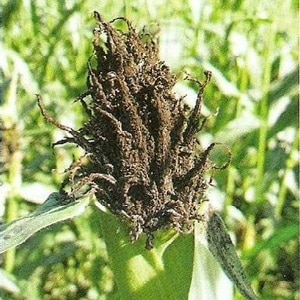 A fungal disease affects the cobs, inflorescences and panicles of the plant. The panicles turn into a dusty gray clot, the cobs into a black lump. The fungal spores live inside the plant until the corn ripens. It becomes deformed, the bush takes on an ugly shape.
A fungal disease affects the cobs, inflorescences and panicles of the plant. The panicles turn into a dusty gray clot, the cobs into a black lump. The fungal spores live inside the plant until the corn ripens. It becomes deformed, the bush takes on an ugly shape.
Sources of infection are spores that live in the ground, the remains of other plants, and on the surface of grains. Loose smut destroys 20 to 40% of the crop.
To prevent the appearance of the disease, it is recommended to choose fungus-resistant hybrids, observe planting dates, and remove the remains of last year’s plants. The drug “Stimix” is used for treatment. It is effective and does not harm humans and the environment.
Blister smut
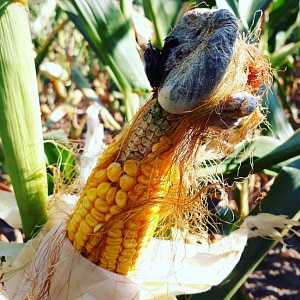 Bladder smut is a disease of corn cobs. A fungal disease manifests itself in the form of rough, white swellings. They appear on the stem, cobs, roots, leaves and panicles.
Bladder smut is a disease of corn cobs. A fungal disease manifests itself in the form of rough, white swellings. They appear on the stem, cobs, roots, leaves and panicles.
As they develop, the swellings turn into olive-colored dust. Bladder smut affects young corn and mature plants, causing the corn to become deformed and die.
The fungus appears due to dense plantings, hot climates, and prolonged drought. Productivity is reduced by 10-25%.
For prevention, before planting, the seeds are disinfected and sprayed with Prosaro. For the treatment of blister smut, the drug “Propulse” is used.
This is interesting:
What varieties of corn are there and how to choose the best one
Fusarium
Fusarium appears in regions with high humidity and hot climates. The disease affects the plant at the beginning of ripening.
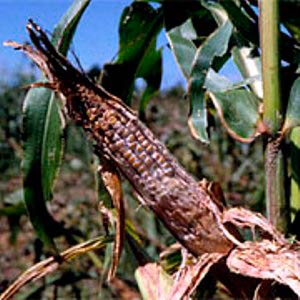 Several foci of infection appear on the cob, which eventually spread throughout the plant. The grains acquire a crumbly structure, are easily pressed, and become white or pink.
Several foci of infection appear on the cob, which eventually spread throughout the plant. The grains acquire a crumbly structure, are easily pressed, and become white or pink.
The following methods are used for prevention:
- Fusarium-resistant hybrids are planted;
- follow the landing rules;
- monitor the watering and fertilizing regime.
If the disease appears, the infected ears are immediately removed, the remaining plants are sprayed with Proteus.
It is recommended to store corn in a dry and well-ventilated cellar with a humidity of at least 80%.
Important! Fusarium also occurs on harvested cobs. The reason is high humidity and improper storage.
Stem rot
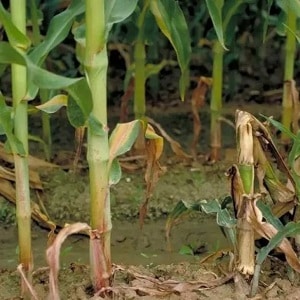 Stem rot occurs due to infected remains of last year's plants, thickened planting, and weeds.. Stems and leaves become fragile and thin, covered with a dark coating, rot and die. Stem rot occurs in rainy and hot weather.
Stem rot occurs due to infected remains of last year's plants, thickened planting, and weeds.. Stems and leaves become fragile and thin, covered with a dark coating, rot and die. Stem rot occurs in rainy and hot weather.
For preventive purposes, before sowing, seeds are treated with a solution of potassium permanganate or succinic acid, hardened and germinated in damp gauze. The drug “Estet” is used for treatment.
Southern helminthosporiosis
The disease affects cobs, stems and leaves. Large red and gray spots appear, which become larger over time and turn into dead areas. The seeds turn black, the cobs become covered with a dark coating. The source becomes contaminated seed material, plant residues, and insect pests.
For preventive purposes, the rules and planting density are observed, and hybrids with high immunity are used. Southern helminthosporiosis is treated with the drug “Tabu Super”.
Diplodia
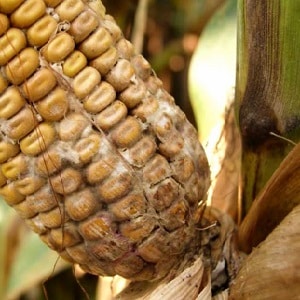 Diplodia affects young plants. The stems become covered with dark spots and become brittle and brittle. Brown spots appear on the leaves, and light mycelium appears on the cobs.
Diplodia affects young plants. The stems become covered with dark spots and become brittle and brittle. Brown spots appear on the leaves, and light mycelium appears on the cobs.
To combat, agrotechnical measures are used: they observe the timing of sowing and harvesting, destroy plant residues, and apply balanced mineral and organic fertilizers. Among the professional remedies for the treatment of diplodia, “Triton” and “Quasar” are suitable.
Wilt (bacterial wilt)
Wilting affects the leaves - they become thin and acquire a yellowish tint.. The ends become discolored and dry out. The plants do not bear fruit; ripe ears produce damaged grains. If a disease is detected, the bushes are cut and burned.
Prevention is achieved by timely weeding and weed control.
Take note:
Corn pests
In addition to diseases, insect pests occur on plants. Let's look at the most common cases.
Stem borer
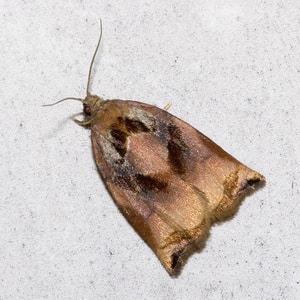 The caterpillar settles inside the stem, over time gnaws tunnels in the plant, eats corn cobs and panicles. Brown crumbs fall out of the holes onto the ground. One plant contains from 1 to 3 caterpillars, which leads to a reduction in yield by 80%. The stems dry out and break. The pest actively reproduces during periods of high humidity and heat. The adult looks like a brown aphid. For the fight, the drug “Decis” is used.
The caterpillar settles inside the stem, over time gnaws tunnels in the plant, eats corn cobs and panicles. Brown crumbs fall out of the holes onto the ground. One plant contains from 1 to 3 caterpillars, which leads to a reduction in yield by 80%. The stems dry out and break. The pest actively reproduces during periods of high humidity and heat. The adult looks like a brown aphid. For the fight, the drug “Decis” is used.
Root aphid
Root aphid settles on the roots and base of the stem. It sucks nutritious juices from the plant, causing the corn to dry out and turn yellow. The pest retards plant growth and increases the risk of fungal diseases. For prevention and treatment, it is recommended to spray corn with Bordeaux mixture.
Important! Gardeners advise cutting the stems as close to the ground as possible when harvesting. Before winter, all plant residues are removed from the fields and deep plowing is carried out.
Swedish fly
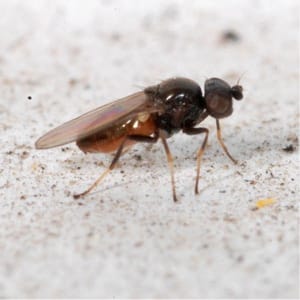 Little black pest affects corn at any stage of development. Flies lay eggs in the plant, the larvae penetrate deep into the stem, where they feed on the juices and vitamins of the corn. Damaged stems wither, but the rest of the plant can be saved.
Little black pest affects corn at any stage of development. Flies lay eggs in the plant, the larvae penetrate deep into the stem, where they feed on the juices and vitamins of the corn. Damaged stems wither, but the rest of the plant can be saved.
For preventive purposes before planting the seed material is treated and tested for germination. For treatment, the drug “Esthete” is used.
Wireworm
Worm lives deep underground, survives at low temperatures. Destroys the roots of the plant, which is why it does not receive nutrients from the soil. Plants get sick and die.For prevention, before sowing, the beds are carefully dug up, ammonia fertilizers are applied, and beetle eggs are collected by hand. For treatment, the drugs “Bazudin” and “Nemabakt” are used.
Prevention of diseases and pests
In order not to waste time and energy fighting diseases and pests, It is recommended to carry out preventive measures in advance and save the harvest:
- Digging the soil before sowing and loosening it prevents the appearance of insect pests.
- Late autumn plowing of the soil protects against wireworms and corn aphids.
- For protection, green lettuce is sown between the rows. Its roots attract pests that forget about the corn and move on to more appetizing prey.
- To prevent the occurrence of diseases, corn is watered with warm and clean water.
- Before planting, the acidic soil is limed by adding a mixture of dry lime and wood ash.
Conclusion
Corn diseases are dangerous because they can destroy from 10 to 40% of the crop. To avoid this, it is recommended to use insecticides and agricultural practices that are effective but safe for human health. Before sowing, the seeds are disinfected and germinated, and the optimal planting density is maintained on the site.
To prevent the appearance of pests, it is recommended to weed the beds, remove weeds and remnants of last year’s plants.